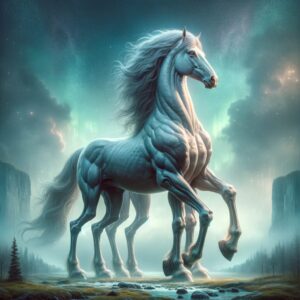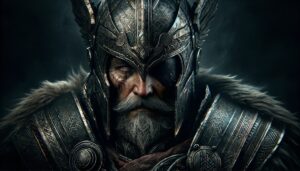Table of Contents
Sleipnir, the magnificent eight-legged horse of Odin, the chief god in Norse mythology, is a creature of unparalleled significance and power. Born from the union of the trickster god Loki and the stallion Svaðilfari, Sleipnir’s origins are steeped in both divine intrigue and extraordinary lineage.
Origins and Family
The union between Loki and the stallion Svaðilfari is one of the most intriguing and unusual episodes in Norse mythology. This event occurred during the construction of the protective walls of Asgard, the realm of the gods. The story unfolds as follows:
A giant named Hrimthurs, in the form of a massive stallion named Svaðilfari, offered his assistance to the gods in building the impregnable walls of Asgard. The gods reluctantly accepted, but only under the condition that the giant would complete the work within a certain time frame, which seemed impossible given the enormity of the task.
To sabotage the giant’s efforts, the trickster god Loki hatched a cunning plan. He transformed himself into a mare and lured Svaðilfari away from the construction site, causing delays in the wall’s completion.
During Loki’s time in the form of a mare, he became impregnated by the giant stallion, Svaðilfari. When Loki later returned to Asgard, he gave birth to an extraordinary eight-legged foal, which would become known as Sleipnir.
The birth of Sleipnir is a testament to the mystical and shape-shifting abilities of Loki, who could take on various forms at will. Sleipnir’s unique lineage, born from a union between a god in disguise and a giant’s stallion, adds to the horse’s mystique and otherworldly qualities.
Appearance and Abilities

Sleipnir’s appearance is striking; with its eight powerful legs setting it apart from all other horses. Furthermore, this unique feature makes it the swiftest and most agile steed in all of Norse mythology. Additionally, with eyes that gleam like burning embers and a coat as black as the night, Sleipnir embodies an otherworldly beauty. Moreover, its strength and speed are unparalleled, allowing Odin to traverse the realms with ease.
Sleipnir’s abilities transcend mere physical prowess. This extraordinary horse has the power to traverse between realms, serving as Odin’s invaluable companion in his role as the Allfather. With its eight legs, Sleipnir effortlessly carries its rider through both the realms of the living and the dead, facilitating Odin’s duties as a god of knowledge, war, and death. Its exceptional attributes encompass unmatched speed, agility, flight, and effortless swimming, making Sleipnir an indispensable and versatile companion in Odin’s divine journeys and quests.
Symbolism and Cultural Impact
Sleipnir stands as a symbol of divine power and transcendence in Norse mythology. Its eight legs symbolize the horse’s ability to traverse not only the physical world but also the realms of thought and spirit. This symbolism aligns with Odin’s quest for wisdom and knowledge, as he constantly seeks to expand his understanding of the cosmos.
In Norse culture, Sleipnir’s image and symbolism have been embraced and immortalized in various forms of art, including runestones and ancient carvings. The horse’s presence in Norse mythology serves as a testament to the multifaceted nature of Odin and the complexities of the divine.
Myths and Stories

One of the most famous stories involving Sleipnir is its role in helping Odin retrieve the mead of poetry, a mythical beverage that grants immense knowledge and creativity. Odin’s journey to secure this mead took him to the home of the giant Suttungr. In his pursuit, Odin transformed into a snake and, with the help of Loki, acquired the mead. He then used Sleipnir’s swiftness to escape the giant’s wrath, further illustrating the horse’s crucial role in Odin’s endeavors.
Another story involving Sleipnir recounts its use during the god’s frequent travels between the realms. Whether seeking wisdom in the depths of Yggdrasil, the World Tree, or riding valiantly into battle, Sleipnir was always at Odin’s side, cementing its reputation as an indispensable and iconic creature in Norse mythology.
Sleipnir: An Eternal Companion
Sleipnir, with its eight legs, distinctive appearance, and unparalleled abilities, is more than just a mythical creature; it is a symbol of Odin’s power, wisdom, and quest for knowledge. Its presence in Norse mythology enriches the tales of the gods and underscores the enduring fascination with this legendary eight-legged steed. From its enigmatic birth to its pivotal role in Odin’s exploits, Sleipnir remains an eternal and captivating companion in the mythic tapestry of the Norse pantheon.
FAQ
How did Sleipnir come into existence?
Sleipnir was born when the trickster god Loki transformed into a mare to distract the giant builder who was building the walls of Asgard. Loki mated with the giant's stallion, resulting in the birth of Sleipnir.
What is the significance of Sleipnir's eight legs?
Sleipnir's eight legs are symbolic of its incredible speed and agility, making it the swiftest and most extraordinary horse in Norse mythology.
What role does Sleipnir play in Norse mythology?
Sleipnir is primarily associated with Odin and is often depicted as Odin's trusted steed. It aids Odin in traversing the realms, including the land of the living, the realm of the dead (Hel), and other mythological worlds.
Are there any specific stories or adventures involving Sleipnir?
Sleipnir plays a significant role in various Norse myths and sagas, but one of its most notable appearances is in the Prose Edda, where it helps Odin on his journey to consult the wise being Mimir at the Well of Wisdom.
What are the physical attributes of Sleipnir?
Sleipnir is described as having eyes that gleam like burning embers and a coat as black as the night, which gives it an otherworldly and striking appearance.
Can anyone ride Sleipnir, or is it exclusively Odin's steed?
Sleipnir is primarily associated with Odin, but there are instances in Norse mythology where others, including gods and heroes, have ridden Sleipnir on special occasions.
Does Sleipnir have any special abilities or powers?
Sleipnir's most notable abilities are its incredible speed and agility, allowing it to traverse the realms with ease.
Is Sleipnir still relevant in modern culture?
Yes, Sleipnir continues to be a fascinating and iconic figure in modern popular culture, appearing in books, movies, video games, and other forms of entertainment.




